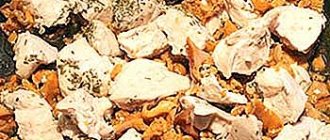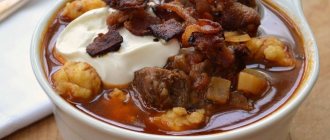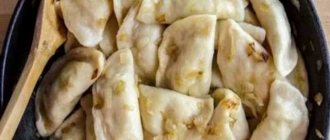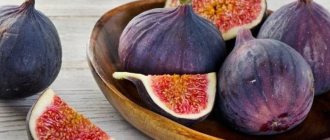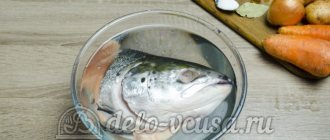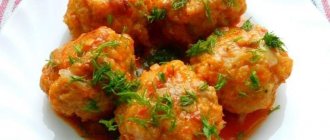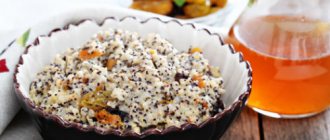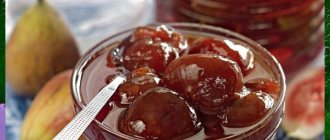Fresh fruits
It is difficult to select fresh figs, because... a large number of factors need to be taken into account. The first thing you need to know about figs (the second name for figs) is that the shelf life of the ripe fruit is only 2 weeks. This period is short in order to collect the fruits, and then transport them to another country and sell the harvest.
These factors have led to the fact that mainly dried or dried figs are exported.
It is not uncommon for unripe fruits to go on sale, because... figs are able to ripen while being transported. But such fruits do not have the required amount of sugar, like freshly picked ripe fruit; they remain hard and have practically no taste.
There is a list of qualities that you need to adhere to when choosing fresh figs:
- the aroma of the fruit should not be sour, otherwise this indicates that the fermentation process has begun inside;
- the fruit should be firm and elastic on top, and soft inside;
- figs are softer than necessary and can often be rotten inside;
- very hard fruits indicate immaturity and lack of taste;
- The color of the fruit does not matter in the choice, because... Figs have several varieties that differ in their color.
After purchasing figs, you need to eat them within 2 days. Alternatively, you can freeze the fruits, which will preserve all the vitamins and microelements. The shelf life of the frozen product is 1 year, and after the figs are defrosted, they must be consumed within 2 hours. You can make confiture from fresh fig fruits.
Dried fruits
Before buying dried figs, you need to know that such products are subject to processing, and especially often chemical processing. This is done to make the dried fruit look attractive. All dried fruits, without exception, are subject to treatment with sulfur dioxide, which in the food table corresponds to E 220.
This happens so that all kinds of insects and pests do not spoil the fruits, which not only people love to feast on.
In order for dried fruits to have a beautiful glossy sheen, figs are smoked using sulfur fumes. Dry fruit is often subject to processing with petroleum products. These are not all the chemical influences that can be used when drying fruits. There are a number of chemical treatments that are aimed at any type of fig.
To choose the right more or less natural product, you need to rely on the following factors:
- Figs should have a light beige color; a matte sheen from sugar crystallization is also allowed.
- The shape of the fruit should be slightly flattened and spring back when touched with your fingers.
- The taste of the dried fruit should be tart-sweet, and the fig itself should be crunchy to the touch from the seeds. No special effort should be made when chewing.
- When choosing fruit in factory boxes, it is worth studying the manufacturer’s company more carefully.
- It is best to buy fruits in organic food stores. Despite the difference in price, the quality of the goods sold in such stores is higher.
Using water you can remove as much sulfur dioxide as possible. To do this, you need to soak the figs in cold liquid several times. The first time you need to pour the berries for half an hour. Then drain the water and refill for 15 minutes. After this procedure, thoroughly wash each dried fruit under running warm water.
This procedure will not only minimize the presence of chemical treatment, but will also remove dirt, which is a source of various infections.
You can also dry fig fruits yourself, which will be healthier than store-bought ones and are definitely not subject to additional chemical treatment. To do this, you need to buy berries, based on the recommendations described above for choosing fresh fruits. A berry 4-5 cm in size is suitable. It is better to choose a white fig variety with numerous seeds, since the number of seeds indicates the quality of the fruit.
The best fruit has a large number of seeds. The washed figs are placed in an electric dryer for a while and you are done. When choosing an electric drying device, it is worth considering the presence of a temperature range that starts at +35°C. The ideal shape for pallets is square.
Fruits in any form are rich in many vitamins and microelements. Figs contain large amounts of iodine, B vitamins, beta-carotene, sodium, phosphorus, potassium and magnesium. This combination also includes iron and nicotinic acid. This composition gives dried berries such a specific taste.
Fig color when choosing
Many people are interested in how to choose figs. When choosing a ripe fruit, you should not pay attention to color and size, because... The color of the fruit depends on the species. The shade of the fruit, as well as the size, can be different; for example, there are fruits that do not exceed the size of a walnut and have a dark blue color.
Buyers do not take small berries, considering this variety to be wild, but ripe fruits should be sweet. As a rule, the color of the berries is brown, blue-black or yellow-green.
The variety, which can be found in the Caucasus, is large in size, the fruits are green in color with a yellow tint. Despite the name of the variety “Royal”, the fruits look inconspicuous. Basically, the ripe fruit has a bright color with a slightly open top.
Dried fruits that have not been treated with various chemical compounds should be brown in color and look like dry skin. When choosing a dried fruit, you need to pay attention to the fleshiness and size of the berry, since large dried figs may be treated with some kind of chemical.
How to choose the right figs?
Fresh figs also contain small amounts of which have antioxidant properties 7. The most common are lycopene, followed by lutein and beta-carotene 7. Note that carotenoids are better absorbed in the body when small amounts of fat are consumed at the same time 9. Rice with several walnuts or cheese make a great healthy snack.
Dietary Fiber Fresh and dried figs contain about 30% soluble fiber and 70% 4. A 60 ml portion of dry figs provides 10% of the recommended daily intake of fiber for men aged 19 to 50, and 15% of women the same age 12. In general, a high-fiber diet is associated with a lower risk of colon cancer 13. Soluble fiber can help normalize blood cholesterol, glucose and insulin levels, which can help treat cardiovascular disease and type diabetes.
So that you can safely eat berries in any form and get the benefits, you need to buy a quality product. Here are the characteristics of good fresh figs:
- it should be slightly soft, but hold its shape steadily and not fall apart in your hands;
- the skin should be smooth and without cracks, but small scratches are not considered a fault;
- the smell of ripe fruits is pleasant and sweetish; sour indicates the beginning of the fermentation process;
- a large number of seeds, as a rule, indicates excellent taste.
Dried figs of the highest quality have a pleasant light brown color. All berries are smooth, regular, slightly flattened in shape and relatively soft to the touch. White coating on the fruit is an indicator of high sugar content. To avoid running into low-quality figs, you need to touch them. Rough and dry fruits are most likely past their expiration date. In addition, such berries have an unpleasant sour taste.
As for insoluble fiber, it helps maintain adequate intestinal function. Calcium in figs? However, the calcium content of some plants varies, Absorption of this mineral in the body 11. Although the bioavailability of calcium in dried figs is unknown, supplementation with this dry fruit is still an interesting means of increasing calcium intake. Figs have recently been incriminated with oral allergy syndrome 24. This syndrome takes the form of an allergic reaction to certain proteins in various fruits, vegetables and nuts.
Smell
Figs should not have any specific chemical odor. After purchasing dried fruits, it is necessary to soak the figs to release all the chemical elements that were in the fruit, even if they did not have any specific smell. Dried fruits can smell like iodine due to the large amount of this element in the berries. The fresh version has a special light smell of grass and sweetness that cannot be compared with anything else.
The taste of dried fruit depends on the number of seeds inside it. The more seeds, the tastier, juicier and sweeter the fruit. The taste of the “Royal” dried fruit from the Caucasus outshines many foreign varieties. It has slightly fewer seeds, which are beneficial for humans as they are a source of many vitamins and minerals. The dried fruit has a sweet taste with a specific hint of iodine.
—Categories
- ENGLISH LANGUAGE (69)
- APHORISMS, THOUGHTS, STATEMENTS (202)
- ACCOUNTING (29)
- VIDEO (65)
- KNITTING (1567)
- mittens, socks, slippers (26)
- infants (389)
- girls (218)
- for home (79)
- for men (21)
- women's (484)
- magazines, miscellaneous. (5)
- boys (99)
- calculation of yarn consumption, number of loops; pattern (21)
- tips, lessons (119)
- schemes, patterns (133)
- DACHA (1095)
- gazebos, fireplaces, barbecues (51)
- pest control, disease control, fertilizer (94)
- grapes (9)
- mushrooms (8)
- beds (18)
- house. interior (127)
- calendar (56)
- clematis (10)
- strawberries, raspberries and other berries (45)
- landscape design (220)
- onion, garlic (15)
- pruning trees and shrubs (15)
- cucumbers (21)
- miscellaneous (124)
- seedlings, saplings (49)
- rhododendron (7)
- roses (36)
- garden, vegetable garden (118)
- salad, herbs, radishes, carrots (24)
- tomatoes, peppers, zucchini, eggplants (28)
- tulips, daffodils, hyacinths, lilies, irises (21)
- conifers (16)
- DIET (128)
- FOR CHILDREN. LESSONS (279)
- English (35)
- mathematics (16)
- miscellaneous (90)
- drawing (67)
- Russian language (6)
- fairy tales (42)
- reading (26)
- PAINTING (243)
- HEALTH (553)
- Hair (7)
- Women's diseases (3)
- Skin diseases (4)
- Foot diseases (8)
- Diseases of the liver, pancreas, gall bladder (4)
- Colds (13)
- Cardiovascular diseases (11)
- Joint diseases (6)
- Cleansing the body (2)
- Miscellaneous (71)
- INTERIOR (181)
- balcony (9)
- living room (2)
- children's (12)
- kitchen (12)
- miscellaneous (81)
- bathroom (10)
- bedroom (5)
- curtains (9)
- HISTORY (45)
- HISTORY OF RUSSIA (71)
- for EASTER (43)
- FOR CHRISTMAS, NEW YEAR (205)
- toys (33)
- design (30)
- cooking (29)
- postcards (24)
- embroidery (16)
- music (9)
- BOOKS (43)
- COMPUTER (305)
- postcards (87)
- miscellaneous (147)
- photoshop (34)
- COOKING. 1ST, 2ND COURSES (693)
- vegetable dishes (53)
- dishes made from rice, oatmeal and other cereals (41)
- hot chicken dishes (118)
- hot meat dishes (91)
- hot fish and seafood dishes (155)
- casseroles (41)
- potatoes (34)
- omelette (14)
- pasta (45)
- dumplings, dumplings, dumplings (22)
- sauces (29)
- soup (61)
- COOKING. BAKERY (941)
- dancing (49)
- cheesecakes (23)
- waffles, corrugations (9)
- cupcakes (66)
- baskets (17)
- cream, marzipan, icing (19)
- macaroons (4)
- savory pastries (125)
- cookies (140)
- cakes (82)
- pizza (8)
- sweet pies (103)
- curd cakes, cheesecakes (65)
- cakes (199)
- bread, rolls (40)
- COOKING. DESSERT (171)
- meringue (10)
- tiramisu (4)
- candies (52)
- marmalade, Turkish delight (11)
- milkshakes, smoothies (6)
- ice cream (17)
- miscellaneous (63)
- soufflé (8)
- COOKING. SNACK (536)
- salads with fish, seafood (38)
- pancakes (30)
- salads with chicken, duck (18)
- sauces and pastes (17)
- salads with meat (9)
- hot sandwiches, flatbreads (44)
- salad dressings (14)
- design ideas (13)
- meat snack (94)
- vegetable snack (71)
- miscellaneous (4)
- fish appetizer (55)
- vegetable salads (71)
- cheese appetizer (23)
- toasts, canapés, tartlets, vol-au-vents, etc. (53)
- COOKING. MISCELLANEOUS (467)
- jam, jam (48)
- Magazines (27)
- blanks (95)
- drinks (120)
- selection of recipes (52)
- herbs and spices (30)
- serving, dishes (12)
- tips (64)
- cheese (24)
- LEGENDS AND MYTHS (62)
- SMALL HOME TRICKS (99)
- FASHION (99)
- MUSIC (319)
- classical (128)
- rock (58)
- pop (35)
- jazz, blues (35)
- modern (62)
- TRAVEL (492)
- Abkhazia (1)
- Austria (25)
- England (18)
- Belgium (1)
- Bulgaria (5)
- Hungary (3)
- Germany (38)
- Greece (22)
- Dominican Republic (1)
- Egypt (8)
- Israel (7)
- India (7)
- Indonesia (5)
- Spain (35)
- Maps, guides, tips (45)
- Cyprus (1)
- China (13)
- Cuba (1)
- Latvia (2)
- Maldives (2)
- Malta (5)
- Morocco (2)
- Mexico (3)
- Monaco (2)
- Norway (6)
- UAE (14)
- Peru (4)
- Poland (16)
- Portugal (6)
- Singapore (1)
- Thailand, Vietnam (7)
- Türkiye (12)
- Ukraine (31)
- France (91)
- Croatia (16)
- Montenegro (12)
- Czech Republic (19)
- Switzerland (6)
- Japan (1)
- TRIPS. ITALY. (178)
- Veneto. Venice, Verona (18)
- Amalfi, Ravello, Positano, Salerno (4)
- Apulia (3)
- Italy. Various interesting places (8)
- Italian language (23)
- maps, attractions, tips (3)
- Lazio. Rome, Vatican, Sperlonga, Ponza Island (64)
- Liguria. Genoa, Sanremo (2)
- Milan (4)
- Naples, Capri, Ischia (8)
- O. Sardinia (2)
- O. Sicily (17)
- Lake Garda (2)
- Lake Como (3)
- Tuscany. Florence, Siena, Pisa, Lucca (12)
- Umbria (2)
- Emilia-Romagna. Bologna, Parma (3)
- TRIPS. RUSSIA. (180)
- Golden Ring of Russia (8)
- Interesting places in Russia (28)
- Moscow and Moscow region (91)
- St. Petersburg and Leningrad region (53)
- RADIO (4)
- HOUSE PLANTS (37)
- RELIGION (38)
- HANDCRAFTS (884)
- hairpins, headbands, flowers for them (22)
- beads (20)
- embroidery (286)
- toys (287)
- toys made from salt dough and BISCUIT (50)
- mosaic (8)
- other (82)
- motifs, ornaments, stencils (98)
- furniture painting (32)
- WEDDING (114)
- TIPS (248)
- LINKS (15)
- DESTINY (149)
- FITNESS (49)
- PHOTO (63)
Recipe Salad with figs and goat cheese. Calorie, chemical composition and nutritional value.
Nutritional value and chemical composition of “Salad with figs and goat cheese.”
The table shows the nutritional content (calories, proteins, fats, carbohydrates, vitamins and minerals) per 100 grams of edible portion.
| Nutrient | Quantity | Norm** | % of the norm in 100 g | % of the norm in 100 kcal | 100% normal |
| Calorie content | 176.7 kcal | 1684 kcal | 10.5% | 5.9% | 953 g |
| Squirrels | 5.7 g | 76 g | 7.5% | 4.2% | 1333 g |
| Fats | 15.3 g | 56 g | 27.3% | 15.4% | 366 g |
| Carbohydrates | 5.1 g | 219 g | 2.3% | 1.3% | 4294 g |
| Organic acids | 0.2 g | ~ | |||
| Alimentary fiber | 1.1 g | 20 g | 5.5% | 3.1% | 1818 |
| Water | 56.9 g | 2273 g | 2.5% | 1.4% | 3995 g |
| Ash | 0.731 g | ~ | |||
| Vitamins | |||||
| Vitamin A, RE | 143.1 mcg | 900 mcg | 15.9% | 9% | 629 g |
| beta carotene | 0.346 mg | 5 mg | 6.9% | 3.9% | 1445 g |
| Vitamin B1, thiamine | 0.057 mg | 1.5 mg | 3.8% | 2.2% | 2632 g |
| Vitamin B2, riboflavin | 0.046 mg | 1.8 mg | 2.6% | 1.5% | 3913 g |
| Vitamin B4, choline | 3.45 mg | 500 mg | 0.7% | 0.4% | 14493 g |
| Vitamin B5, pantothenic | 0.196 mg | 5 mg | 3.9% | 2.2% | 2551 g |
| Vitamin B6, pyridoxine | 0.084 mg | 2 mg | 4.2% | 2.4% | 2381 g |
| Vitamin B9, folates | 24.691 mcg | 400 mcg | 6.2% | 3.5% | 1620 g |
| Vitamin C, ascorbic acid | 7.81 mg | 90 mg | 8.7% | 4.9% | 1152 g |
| Vitamin E, alpha tocopherol, TE | 1.23 mg | 15 mg | 8.2% | 4.6% | 1220 g |
| Vitamin H, biotin | 0.442 mcg | 50 mcg | 0.9% | 0.5% | 11312 g |
| Vitamin K, phylloquinone | 24.7 mcg | 120 mcg | 20.6% | 11.7% | 486 g |
| Vitamin RR, NE | 0.755 mg | 20 mg | 3.8% | 2.2% | 2649 g |
| Niacin | 0.682 mg | ~ | |||
| Macronutrients | |||||
| Potassium, K | 187.03 mg | 2500 mg | 7.5% | 4.2% | 1337 g |
| Calcium, Ca | 19.76 mg | 1000 mg | 2% | 1.1% | 5061 g |
| Magnesium, Mg | 34.96 mg | 400 mg | 8.7% | 4.9% | 1144 g |
| Sodium, Na | 88.81 mg | 1300 mg | 6.8% | 3.8% | 1464 g |
| Sera, S | 5.72 mg | 1000 mg | 0.6% | 0.3% | 17483 g |
| Phosphorus, Ph | 115.7 mg | 800 mg | 14.5% | 8.2% | 691 g |
| Chlorine, Cl | 144.94 mg | 2300 mg | 6.3% | 3.6% | 1587 g |
| Microelements | |||||
| Aluminium, Al | 58.6 mcg | ~ | |||
| Bor, B | 44.2 mcg | ~ | |||
| Vanadium, V | 17.49 mcg | ~ | |||
| Iron, Fe | 1.351 mg | 18 mg | 7.5% | 4.2% | 1332 g |
| Yod, I | 16.2 mcg | 150 mcg | 10.8% | 6.1% | 926 g |
| Cobalt, Co | 2.294 mcg | 10 mcg | 22.9% | 13% | 436 g |
| Lithium, Li | 4.115 mcg | ~ | |||
| Manganese, Mn | 0.8004 mg | 2 mg | 40% | 22.6% | 250 g |
| Copper, Cu | 156.09 mcg | 1000 mcg | 15.6% | 8.8% | 641 g |
| Molybdenum, Mo | 3.313 mcg | 70 mcg | 4.7% | 2.7% | 2113 g |
| Nickel, Ni | 4.527 mcg | ~ | |||
| Rubidium, Rb | 63 mcg | ~ | |||
| Selenium, Se | 0.243 mcg | 55 mcg | 0.4% | 0.2% | 22634 g |
| Fluorine, F | 9.05 mcg | 4000 mcg | 0.2% | 0.1% | 44199 g |
| Chromium, Cr | 1.85 mcg | 50 mcg | 3.7% | 2.1% | 2703 g |
| Zinc, Zn | 0.4438 mg | 12 mg | 3.7% | 2.1% | 2704 g |
| Digestible carbohydrates | |||||
| Starch and dextrins | 0.416 g | ~ | |||
| Mono- and disaccharides (sugars) | 3.8 g | max 100 g | |||
| Glucose (dextrose) | 0.078 g | ~ | |||
| Fructose | 0.076 g | ~ | |||
| Essential amino acids | 0.05 g | ~ | |||
| Valin | 0.008 g | ~ | |||
| Histidine* | 0.002 g | ~ | |||
| Isoleucine | 0.005 g | ~ | |||
| Leucine | 0.007 g | ~ | |||
| Lysine | 0.01 g | ~ | |||
| Methionine | 0.004 g | ~ | |||
| Methionine + Cysteine | 0.005 g | ~ | |||
| Threonine | 0.007 g | ~ | |||
| Tryptophan | 0.001 g | ~ | |||
| Phenylalanine | 0.007 g | ~ | |||
| Phenylalanine+Tyrosine | 0.01 g | ~ | |||
| Nonessential amino acids | |||||
| Tyrosine | 0.004 g | ~ | |||
| Cysteine | 0.002 g | ~ | |||
| Sterols (sterols) | |||||
| beta sitosterol | 2.058 mg | ~ | |||
| Saturated fatty acids | |||||
| Saturated fatty acids | 0.7 g | max 18.7 g | |||
| 16:0 Palmitinaya | 0.265 g | ~ | |||
| 18:0 Stearic | 0.051 g | ~ | |||
| 20:0 Arakhinovaya | 0.017 g | ~ | |||
| Monounsaturated fatty acids | 1.377 g | min 16.8 g | 8.2% | 4.6% | |
| 16:1 Palmitoleic | 0.032 g | ~ | |||
| 18:1 Oleic (omega-9) | 1.335 g | ~ | |||
| 20:1 Gadoleic (omega-9) | 0.01 g | ~ | |||
| Polyunsaturated fatty acids | 0.249 g | from 11.2 to 20.6 g | 2.2% | 1.2% | |
| 18:2 Linolevaya | 0.247 g | ~ | |||
| Omega-6 fatty acids | 0.2 g | from 4.7 to 16.8 g | 4.3% | 2.4% |
The energy value of Salad with figs and goat cheese is 176.7 kcal.
Primary Source: Created in the application by the user. Read more.
** This table shows the average levels of vitamins and minerals for an adult. If you want to know the norms taking into account your gender, age and other factors, then use the “My Healthy Diet” application.
Benefits of figs
When we have a cold, we brew tea with raspberries or linden blossoms. And in Mediterranean countries, instead of all this, they treat it with figs. It turns out that if you brew it in boiling water or hot milk, the broth will cause profuse sweating and immediately bring down the temperature. This drug also has an antibacterial effect. This means that pathogenic microbes will leave the body sooner. For a sore throat, gargle with the same decoction. The pain and plaque characteristic of this disease disappear faster.
The diuretic effect that figs have also contributes to faster recovery from colds. It helps the body get rid of waste and toxins.
The laxative effect of this fruit also helps in cleansing from harmful substances. Useful fiber helps remove them from the intestines.
Figs contain many beneficial substances. Here are the most important of them:
- potassium. In terms of its content, figs are second only to nuts. Due to its high potassium content, it is recommended for people with cardiovascular diseases.
- iron. Here figs are ahead of apples. Therefore, it is useful to include it in the diet of people suffering from anemia and vegetarians.
- coumarin. This is a substance that increases the sensitivity of our skin to solar radiation. Therefore, if you want to tan quickly, eat figs.
Useful properties of figs
How can this fruit be beneficial for health?
- Due to its high potassium content, figs can prevent cardiovascular diseases. The fruit of the fig tree strengthens the walls of capillaries and blood vessels, stabilizes the heart rhythm. It is often used as a prophylactic against hypertension.
- Fruits are an excellent source of energy. They improve performance and improve mood.
- Fig decoction helps with sore throat, bronchitis, gum disease, and iron deficiency anemia.
- Dried figs are good for chronic constipation because they contain a lot of coarse dietary fiber. Berries are useful for kidney and spleen diseases.
- The fruits of the fig tree strengthen the immune system, remove toxins from the body, and have a beneficial effect on the functioning of internal organs.
- To quickly heal abscesses and small wounds, use a pulp of fruit pulp. The viscous mass has a beneficial effect on the condition of the skin.
Recommendations for eating fresh figs
- Before eating figs, they must be washed thoroughly. You need to wash it very carefully; you do not need to use a sponge or brush, since fresh fruits are very soft and tender. It is enough to wash off all the dust with your hands under running water.
- The skin of figs is edible, so you don't have to peel them. But some fruits have very thick skin. In this case, you can remove or scrape it out and eat only the pulp, leaving the skin. The stem must be removed before use. It can be cut or unscrewed with your fingers.
- It is advisable to eat figs on the day of purchase, since their shelf life is quite short. Can be stored for no longer than 3-4 days in a cool, dry place.
- The ripe fruit breaks easily, so it is not necessary to use a knife to divide it.
- If fresh figs need to be served as a treat, you can use a knife, cut them into pieces, decorate with coconut flakes, nuts, pour over yogurt or syrup, and garnish with herbs.
Fig salad with mozzarella
I would call it a Russian version of caprese, because you can already buy good mozzarella here, but in the winter, alas, you won’t find truly sweet tomatoes that are necessary for caprese. And sweet beets are always at hand. That's why we will prepare a salad with mozzarella and beets. And as companions we’ll take figs and green salad. Figs are my great love.
But if you couldn’t find fresh figs, then replace them with dates, just pour boiling water over them first to make them softer and more tender. If you already have boiled beets in the refrigerator, all that remains is to chop everything, assemble the salad according to the recipe and serve, everything will take about ten minutes.
The trick here is in the refueling. While we prepare the lettuce and cut the mozzarella, we leave the beets to lightly marinate with olive oil, vinegar and garlic.
You know, sometimes in our lives there is such a heap of things to do, there is no time, the children want to eat, the husband is about to come home from work, and we need to quickly put something on the table. In my life, such situations happen quite often. What helps me is optimism, the ability to improvise and... homemade preparations.
It also calls for some aromatic herb, I especially like thyme - its slightly citrusy taste suits beets very well. Then place the salad on a flat plate and lightly season each layer with its own separate dressing. When all the ingredients are on the fork, you will feel how rich our impromptu salad has a taste, fresh and sweet at the same time. Just don’t overuse salt - it seems to me that it is the insipid tenderness of mozzarella that makes all the varied ingredients sing in a harmonious chorus.
Number two today is pink spaghetti. Don’t be surprised, we don’t use any dyes, but rely on the same beets. In general, beets are a very bright ingredient, not only in color, but also in taste.
She is, after all, a root vegetable!
It’s this richness of shades that we’ll play with, shading the sweetness of the beets with salty feta. The French make a similar salad dressing with lemon juice.
Our projects. You can enter a new search or go to one of our sections, such as recipes.
Encyclopedia Culinary calendar special projects. International Tea Day. Enter at least 2 characters to search. Cooking school. Shop new. Enter at least 3 characters to search. Add a recipe. Video recipes on the topic. Goat cheese salad. Salad with potatoes, bacon, beans and poached eggs. Pumpkin salad with lentils.
Photo reports
Salad with lentils and boiled pork. In a cookbook. To favorites. With images Without images. Nutritional value per serving. Protein 18g Fat 28g Carbs 31g Based on your age, weight and activity.
Serves as reference information. To the shopping list Loading your shopping lists New shopping list. It will also come in handy for you. K Knife for chopping 20 cm “Comfort” made of stainless steel. Add a photo. In full screen. Place lettuce leaves on a plate, sprinkle with 1 tbsp. Place ham, mozzarella, raspberries and figs on lettuce leaves. Drizzle everything with the remaining olive oil and balsamic vinegar, salt and pepper.
What dishes can you add fresh figs to?
- Fresh figs can be added to porridge. This will make breakfast not only tasty, but also healthy. To do this, you need to chop it and add it to the finished porridge. If desired, you can additionally add honey or nuts.
- Fruit salad. Fresh figs can be combined with other fruits and berries. Dressings for fruit salad can be varied, depending on taste preferences: yogurt, sour cream, cream, etc.
- Figs go well with cheese and sour cream. You will need large figs, cheese, walnuts, honey. Fresh figs
it is necessary to wash with running water, dry, remove the stem, make cross-shaped cuts from top to the middle of the fruit. Place a small piece of cheese into the resulting cavities, pour honey on top and decorate with walnuts. - Figs can be added to baked goods as a topping, combined with other fruits, or as a main filling. This fruit is also useful for decorating desserts, cakes and pastries.
- Fig jam. Sprinkle the fig slices with sugar and cook over low heat.
- Fresh figs with cream. You can please your loved ones with this dish not only on weekdays, but also serve it as a dessert on a holiday table. To prepare, you need to prepare small bowls that are filled with whipped cream. Figs are cut into slices. You need to insert a skewer into each slice. The fig slices are laid out on a separate flat plate. Each guest or family member is served one bowl of cream and a plate of figs. The dish is reminiscent of fondue: a slice of fig must be dipped in whipped cream. If desired, you can replace the cream with yogurt or prepare a different sauce.
- Fresh figs go well in salads with meat or seafood. For the salad you will need several figs, lightly salted salmon, and iceberg lettuce. Grind all ingredients, mix and season with olive oil and soy sauce. If desired, you can replace the fish with slices of ham, which must be rolled into rolls and placed on top of the salad.
Salad with figs
Autumn is not a reason to give up light and healthy dishes. One of them is a fragrant salad of figs, arugula, red cabbage, cottage cheese and pomegranate seeds. All ingredients need to be washed, chopped and mixed in a large bowl. Olive oil, flaxseed oil, or a mixture of oils with balsamic vinegar, spices and salt are suitable as a sauce.
Should I peel figs before eating?
The velvety skin of ripe figs is edible, slightly bitter, which highlights the taste of the grainy pulp. Before eating, figs should be washed under running cool water and wiped dry. It is advisable to cut the fruit into four parts with a knife, this will make it easier to eat; the stem must be removed.
It is still better to give your child figs without the skin. To do this, cut the fig in half and give it to the baby with a dessert spoon. Let him eat it out of the skin, like ice cream in a cup.
Fresh figs or fig puree can be given to a child from one year onwards. Dried fruits - from one and a half to two years. But it is important to monitor the baby’s condition after eating an exotic fruit for the first time to find out if there is an allergy to it.
Salad with figs and cherry tomatoes
Line the bottom of the plate with any lettuce leaves. Cut 8 cherry tomatoes in half, cut 3 apricots into slices. Mix all this carefully with your hands. For the dressing, mix 2 tablespoons of balsamic vinegar, 1 teaspoon of mustard and 1 tablespoon of olive oil. Season with salt and pepper, sprinkle with grated walnuts and paremzan on top. Rabbit in fig sauce.
Grind 50 grams of bread crumbs in a blender with almonds. Add 50 grams of dried figs, 3 cloves of garlic, thyme and rosemary. Lightly fry 600 grams of rabbit meat in olive oil, add the previously prepared mixture, add water and simmer for 10 minutes. Then add another 50 grams of coarsely chopped figs and keep on the fire until the meat is cooked.
Peanut and fig candies.
Soak 100 grams of figs and 100 grams of dates for an hour. Grind 60 grams of roasted peanuts in a blender. Remove dried fruits from the water, dry and grind with peanuts. Make candies from the resulting mass and roll them in coconut flakes.
Galette with figs and ricotta
Treat yourself to an unforgettable gastronomic feast and prepare a delicious galette with figs, or maybe two at once! By the way, if you knead the dough in the evening, then preparing an exquisite breakfast from seasonal fruit will not take much time, and most importantly, it will set a positive mood for the whole day.
Filling ingredients:
- 8 figs;
- 100 g ricotta or soft cottage cheese;
- 4 tsp. honey;
- 30 g butter;
- 2 tsp. Sahara;
- 1 tsp. vanillin;
- egg for brushing.
Ingredients for the dough:
- 2 stacks flour;
- 150 g cold butter;
- 3 tsp. powdered sugar;
- 4 tbsp. l. ice water;
- 1 chip salt.
Preparation
- Add salt, powdered sugar and butter cut into small cubes to the sifted flour. Knead the dough until it turns into crumbs.
- Continuing to knead, pour water into the mixture and roll all the ingredients into a ball.
- Divide the finished dough into two parts (you will get two hearty biscuits), form two disks from each, wrap in cling film and place in the refrigerator for 30 minutes.
- While the dough is rising, prepare the filling: thoroughly mix the ricotta, 2 tsp. honey and vanillin. Cut the figs into slices 4–5 mm thick.
- Roll each half of the dough into a circle up to 4 mm thick. Spread the dough with a mixture of ricotta and honey, leaving 5 mm from the edges, place figs on top and sprinkle 1 tsp. Sahara.
- Cut the butter into small cubes and spread evenly over the figs. Fill the top of the fields with the remaining honey.
- Lift the free edges of the dough and fold over the filling. Lightly beat the egg with 1 tsp. water and brush the dough with the mixture.
- Place the biscuits on a baking sheet and place in an oven preheated to 180°C for 25–30 minutes. The figs should be soft and the edges of the dough should be golden.
- Cool the finished biscuits and serve, garnished with a scoop of vanilla ice cream.
Adviсe
The fig is a very textured fruit. When eating it, you can feel both the graininess of the pulp and the delicate elasticity of the peel. Residents of cold regions rarely encounter such properties of food, so for some it may be off-putting for the first time. To taste figs, you need to eat at least a few fruits.
Figs are not recommended for consumption if you have diabetes or irritable bowel syndrome. The latter is explained by the mild laxative effect that is inherent in the southern fruit.
Dried figs can be rehydrated before eating by soaking them in warm water for 15 minutes.
In addition to cheese and yogurt, almost all fermented milk products are combined with figs, especially those that have a high fat content.
Figs can be boiled in water, any fruit juice or wine, adding anise, cinnamon and cloves to taste. The result will be a magnificent oriental sweetness, especially pleasant and healthy in the fall.
Figs are very rich in protein, potassium and magnesium, which is why they are often recommended for inclusion in the diet of pregnant women.
There are also harms from figs; they contain oxalates, which are easily excreted from the body by healthy kidneys. But in case of kidney failure, it is better not to take risks and refuse the fruit, or consume figs in minimal quantities.
Figs are a sweet, nutritious, perishable fruit, so you should choose them carefully and not store them for long. Fig peels are quite edible and add piquancy to the taste; restrictions on them only apply to small children. There are many ways to use figs; they work well with baked goods, sauces or dairy products. But it’s healthier to eat fresh figs for an afternoon snack or second breakfast.
Cough figs with milk - beneficial properties
A medicinal home remedy copes with diseases associated with inflammation of the bronchi, mucous membranes of the throat, laryngitis and sore throat. The remedy is useful for smokers suffering from a characteristic cough associated with an increased concentration of carcinogenic tars and nicotine in the lungs.
Figs are used for colds of various types, as they have antipyretic and diaphoretic properties. The berries contain a substance that can have the same effect as taking acetylsalicylic acid. A prepared fig decoction speeds up recovery associated with sore throat and inflammation of the respiratory organs.
The drug strengthens the immune system, which weakens when there is a cold, and helps remove toxic substances from the body. A drink made from milk and figs, which relieves symptoms of respiratory diseases and coughing attacks and, being a natural product, does not cause side effects in the treatment of adults and children. It has a pleasant taste and is more like a sweet treat than a medicine.
The beneficial properties of figs help with diseases of the heart, kidneys, and stomach. Potassium contained in figs dilates blood vessels and relaxes them, which helps reduce blood pressure and is useful for venous insufficiency.
Recipes used for dry cough help thin and remove mucus. Homemade products are rich in useful elements and vitamins that help restore immunity to immunity and get rid of infection. Due to the presence of fats, it helps relieve inflammation from the throat.
For what diseases should it be taken?
Considering the range of beneficial substances of figs and its healing effects on the body, traditional medicine recommends using the prepared potions for:
Note. A drink made from milk and figs will not replace medications prescribed by a doctor for the treatment of cough. It will only help enhance the effect!
- Acute form of bronchitis;
- Pneumonia;
- Sore throat and hoarse voice;
- Infectious throat diseases (laryngitis, pharyngitis);
- Loss of voice;
- Cough caused by an allergic reaction and leading to irritation of the throat mucosa;
- Rehabilitation of the body at the end of recovery from acute respiratory diseases.
Methods for preparing drinks and dishes from figs
There are a huge number of recipes that recommend eating figs. For example, the first of them says that it is better to pour boiling water over figs, let it brew, and then only use it as a drink.
The second of the possible recipes for preparing figs involves creating various compotes from the berries (figs are washed, filled with water and boiled over low heat after boiling). The third suggests using boiled berries as a filling for pies, cakes and other dough products.
Figs as a side dish for other dishes
Chefs, for example, recommend this recipe. Diced fig particles are fried in a frying pan over low heat, and pieces of chicken are added to them. The dish is fried and served to the table.
There is a recipe for making a dessert from figs stuffed with cheese. Sometimes this dessert is topped with honey, creating an exotic combination of sweet and salty.
By the way, figs are a fairly high-calorie product. It is enough to eat just one fruit of this berry weighing about 15 g for the feeling of hunger to leave you.
The use of figs in folk medicine
Figs can also be used as a medicine; it is not for nothing that lovers of traditional medicine have a way of preparing figs with milk as a drink that relieves coughs and other colds.
In the conditions of our middle zone, figs can be grown in well-heated rooms. Of course, under artificial conditions this berry cannot contain the entire range of useful substances, but one way or another you can grow figs and, without fear of substitution, eat its fruits.
Therefore, remember this berry when preparing dishes for your table. After all, figuratively speaking, the fig tree, collecting the warmth of the sun and the power of water and earth, gives you health and longevity.
Healthy recipes
- Figs for cough. Two ripe fruits should be cut into several parts and placed in an enamel container. Then they are poured with 2 glasses of milk and left for an hour. Next, the mixture is brought to a boil, removed from the stove, covered with a lid and cooled to room temperature. The prepared decoction is taken 1/2 cup before meals three times a day. Figs with milk are an effective remedy for bronchitis and colds.
- Figs for the winter. Washed medium-sized berries are placed in an enamel container, then covered with sugar and left overnight so that the fig gives juice. In the morning, put the syrup with berries on low heat. After boiling, cook for no longer than 25 minutes. When the jam is ready, a brown foam will appear on its surface.
- Hercules with figs. Oatmeal is boiled in milk, then transferred to a plate and fresh figs cut into cubes are added. You can make instant cereal. The finished product does not impair the taste of the fruit.
Figs are eaten with yogurt and natural cottage cheese. If you make a cut on the berry and put a piece of cheese in it, you will get an excellent snack for a glass of champagne. The fruits of the fig tree go harmoniously with baked meat or poultry. Fruit slices add a piquant flavor to the dish.
Figs are rich in microelements and vitamins, but have contraindications. Before using it, it is advisable to familiarize yourself with possible restrictions and consult with your doctor.
You can learn more about the contraindications, benefits and harms of figs here.
Be healthy!
